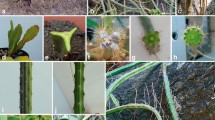Abstract
To assess the taxonomic relationships between the Psilotaceae and the Filicales ( = Polypodiales), certain factors including character divergence, gaps in the record, categorical consistency, conservatism of characters, and use of factual vs. hypothetical data have been given consideration. Although it has been proposed that the aerial shoots of Psilotaceae are homologous to fronds, and the appendages to pinnae, and that the Psilotaceae should be classified as Filicales,Psilotum andTmesipteris show a number of profound differences from Filicales. These involve the structure of the aerial organs, vascular patterns, fertile appendages, and sporangia. In view of the taxonomic criteria used, and the nature of the character differences, it is concluded that the Psilotaceae do not warrant inclusion in Filicales. InsteadPsilotum andTmesipteris constitute a separate line of evolution, and should be treated as a class, the Psilopsida, of Tracheophyta, equivalent to Equisetopsida, Lycopodiopsida, and Polypodiopsida.
Similar content being viewed by others
Literature cited
Bierhorst, D. W. 1971. Morphology of Vascular Plants. Macmillan Co., New York.
Bower, F. O. 1923. The Ferns (Filicales). Vol. I. Analytical examination of the criteria of comparison. Cambridge U. Press.
Copeland, E. B. 1947. Genera Filicum. Chronica Botanica, Waltham, Mass.
Foster, A. S. &E. M. Gifford, Jr. 1974. Comparative Morphology of Vascular Plants. 2nd Ed. W. H. Freeman and Co., San Francisco.
Hagemann, W. 1976. Sind Fame Kormophyten? Eine Alternative zur Telomtheorie. Plant Syst. Evol.124(4): 251–277.
Hofmeister, W. 1851. Vergleichende Untersuchungen der Keimung, Entfaltung, und Fruchtbildung höherer Kryptogamen (Moose, Farne, Equisetaceen, Rhizokarpeen und Lycopodiaceen) und der Samenbildung der Coniferen. Leipzig.
Holttum, R. E. 1954. A Revised Flora of Malaya. Volume II. Ferns of Malaya. Government Printing Office, Singapore.
Parihar, N. S. 1965. An Introduction to Embryophyta. Vol. 2. Pteridophytes. Central Book Depot, Allahabad.
Pichi-Sermolli, R. E. G. 1959. Pteridophyta. pp 421–493. In: W. B. Turrill (Ed.), Vistas in Botany. Pergamon Press, London.
Pritzel, E. 1902. Psilotaceae. pp 606–621. In: Engler and Prantl, Die natürlichen Pflanzenfamilien,1(4).
Reed, C. F. 1966. Index Psilotales. Bol. Soc. Brot.40: 71–96.
Rouffa, A. S. 1967. InducedPsilotum fertile-appendage aberrations. Morphogenetic and evolutionary implications. Canad. Jour. Bot.45: 855–861.
— 1971. An appendageless Psilotum. Introduction to aerial shoot morphology. Amer. Fern. Jour.61(2): 76–86.
Sattler, R. 1975. Organverschiebungen und Heterotopien bei Blütenpflanzen. Bot. Jahrb. Syst.95: 256–266.
Siegert, A. 1964. Morphologische, entwicklungsgeschichtliche und systematische Studien anPsilotum triquetrum Sw. I. Erstarkung und primÄres Dickenwachstum. Beitr. Biol. Pflanzen40: 121–157.
— 1965. Morphologische, entwicklungsgeschichtliche und systematische Studien anPsilotum triquetrum Sw. II. Die Verzweigung (mit einer allgemeinen Erorterung des Begriffes “dichotomie”). Beitr. Biol. Pflanzen41: 209–230.
— 1967. III. Das Blatt aus der Sicht der Homologien. Beitr. Biol. Pflanzen43: 285–328.
— 1969. IV. Die Bildungsabseichungen der Sporophylle. Beitr. Biol. Pflanzen46: 45–71.
Sporne, K. R. 1962. The Morphology of Pteridophytes. Hutchinson Univ. Library, London.
Wagner, W. H., Jr. 1962. Interspecific crosses and spore characteristics in the genusPsilotum (Psilotaceae). Amer. Jour. Bot.49: 680. (Abstract).
— 1964. Paraphyses: Filicineae. Taxon13(2): 56–64.
— 1974. Structure of spores in relation to fern phylogeny. Ann. Missouri Bot. Gard.61(2): 332–353.
Author information
Authors and Affiliations
Additional information
Supported by National Science Foundation Grant DEB 75-03350, Applications of Foliar Characters in the Ferns.
Rights and permissions
About this article
Cite this article
Wagner, W.H. Systematic implications of the Psilotaceae. Brittonia 29, 54–63 (1977). https://doi.org/10.2307/2805741
Issue Date:
DOI: https://doi.org/10.2307/2805741




